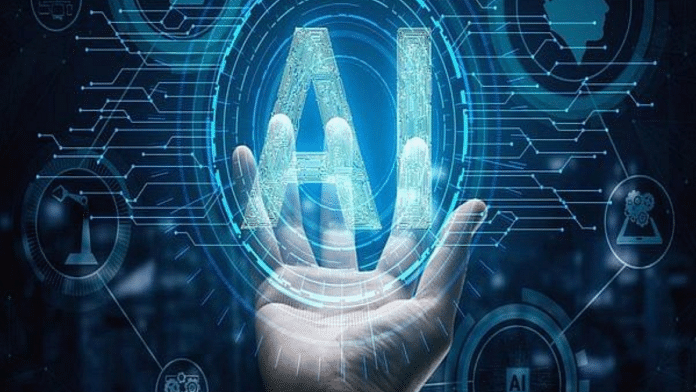New Delhi: The over Rs 10,000 crore corpus announced by the government for its ‘IndiaAI Mission’, which includes the setting up of Artificial Intelligence (AI) computing infrastructure and funding for startups, will give a fillip to research and development in this sector, according to industry experts.
However, they caution that monitoring of data protection and privacy standards to facilitate AI’s growth in India will be crucial.
The Union Cabinet Thursday approved the ‘IndiaAI Mission’ with an outlay of Rs 10,372 crore for the next five years. Under this mission, the government aims to develop infrastructure and ecosystem for AI, including building compute infrastructure of 10,000 or more graphics processing units (GPUs) through public-private partnership and enabling access to quality non-personal datasets to Indian startups and researchers for AI innovation.
Prashanth Kaddi, Partner, Consulting, Deloitte India told ThePrint that infrastructure would give a fillip to this AI ecosystem. “The decision will enable development of India-specific unique solutions and use cases… We have immense digital information and using this could unleash the next wave of innovation. Not many countries or companies have this wealth of data that India has.”
He said while AI has been around for 60 to 70 years now, the availability of data, data storage and sufficient computational power was a challenge. “These factors have always driven up the cost for AI. In the last 10 to 15 years, with the adoption of cloud, some of the issues started getting resolved.”
He pointed out that some functions and uses of AI, such as Generative AI, require very high computational or compute power. “Earlier we used to have just CPUs which had its limitations in terms of how many computations it can parallelly perform and in how much time. GPU enables superior parallel processing ability and reduces the processing time,” Kaddi explained.
This basically means GPUs can perform more complex processes or calculations faster and more efficiently than CPUs.
“Whether 10,000 GPU is enough or not, is too early to say. But the overall announcement is definitely good as we are investing in building the AI ecosystem. One of the challenges that governments are facing is how do you democratise AI-use cases in a significant way. Can we enable people to use it on their mobile devices? So this will provide a very strong ability (for that),” he said.
Likewise, Bhoomika Agarwal, Senior Research Associate at tech-policy think tank The Dialogue, said the move to establish a computing capacity of over 10,000 GPUs marks a significant leap forward in AI research and development.
Also read: Govt clarifies on advisory asking companies to seek nod for AI platforms — ‘won’t apply to startups’
“Focussed on priority sectors like healthcare, these efforts promise tailored AI solutions to bring about positive socio-economic impacts. Further, the mission seeks to train models on datasets covering major Indian languages thus ensuring inclusivity and relevance to the diverse linguistic landscape of the country.”
“The initiative would undoubtedly play a crucial role in democratising the development of AI models,” she added.
Shreya Suri, Partner, Induslaw said the IndiaAI Mission was seemingly a substantial commitment for the government in terms of deployment of resources.
On the development of “IndiaAI Datasets Platform” that will streamline access to quality non-personal datasets to Indian startups and researchers, she said, “There has been talk of a non-personal data governance framework for some time now. However, it is unclear how this data is expected to be collated and whether this will tie into the government’s plans for the Digital India Act proposal as well.”
Suri said what would also require some thought was the scope of what non-personal data would entail and how it must be kept distinct and separate from the widely-defined concept of personal data under the Digital Personal Data Protection Act.
Asked about concerns that could emerge with the proposed use of non-personal data sets, Vaishnavi Sharma, Research Associate at The Dialogue, said while the motivation for protecting personal data was to safeguard the fundamental rights of individuals, the premise for governing non-personal data was two-fold – indirectly protecting personal data, and nurture innovation and empirical research.
Hence, the approach to governing these data will differ based on these premises, she said.
“The discourse on using non-personal datasets for AI training has often been critical of its actual implementation, including data collection, designing, modelling, and operationalising. We now know that it is quite feasible to extract an individual’s personal data from non-personal datasets, especially when designing and operationalising AI models; some residual degree of risk remains even when anonymisation or pseudonymisation techniques have been employed during the AI lifecycle,” Sharma pointed out.
She added that The DPDP Act 2023 provided for an extensive framework to direct the processing of personal data. And given that there is a thin distinction between personal and non-personal data, which may potentially result in harm to Data Principals (to whom the data belongs), it is important to conduct a comprehensive assessment of different sorts of dangers to all — direct and indirect – individuals the datasets may lead to, in case the non-personal datasets are utilised to re-identify individuals.
“While the move to foster responsible innovation and research with open-source, non-personal datasets is welcome, it will be critical to watch how data protection and privacy standards will be applied to enable the growth of AI,” she added.
(Edited by Tikli Basu)



